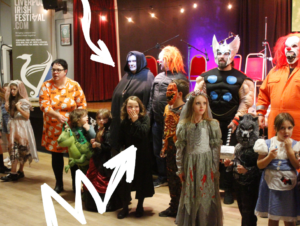
Judy Mazonowicz is a Liverpool writer and activist, who has run St Brigid’s Day activities every year for many years.
The Festival knows Judy through a mutual membership of and representation within Creative Organisations of Liverpool, a diverse collective of key arts organisations in Liverpool, championing the arts; changing perceptions and creating possibilities. We invited Judy to think about St Brigid in the context of our theme ‘hunger’ and our work strand, In:Visible Women. Teamed with St Brigid’s newly gained popularity (in part driven by the Irish Government) and a programme of pioneering events it has been run to join women in the Irish diaspora around the world, Judy explores the legend of St Brigid.
From goddess to saint and back
Next year’s new public holiday in Ireland, on the first Monday in February, will celebrate the transformational Saint Brigid. Initially a Pagan goddess, then canonised (proclaimed a Saint); Brigid’s popularity is re-emerging as she becomes a multidenominational LGBTQ+ icon. Here, I investigate how this may have happened; mention some of her less well-known history and see if we can take inspiration from her, in our food crisis, while placing her in Liverpool.
Brigid
Traditionally, Brigid’s (Bridie, Bride, Brigitte, Bridget, Briganti, etc) crosses are made in celebration of Imbolc. Imbolc is an important day, because it crosses the faiths of Christianity and Paganism, celebrating both goddess and saint simultaneously. Brigid is the guardian of many crafts, including fire, poetry, inspiration, healing and smith work. Sacred wells or springs also mark Brigid in the landscape.
As a child, Brigid was noted to have often given away food and clothing to the poor, frequently performing miracles by refilling larders. Attributions include the patroness of agriculture; watcher over women, children and the poor; as well as an ‘earth mother’, who oversaw the provision of food to the community.
Context
Today, the world needs urgent transformation in food distribution. In 2020, the House of Lords Food Poverty and Environment Committee paper stated that the world “produces enough food to feed twice the global population, yet one in every six of us is undernourished”. What is needed is “a food system […] ensuring safe, healthy, affordable food for all.”
Essential for this change would be Brigid’s approach to overseeing distribution. Like a smithy, she believed in cutting back to the truth of what is essential -in terms of nutrition, packaging and the like- to enforce improvement. Locally, St Bride’s church (Percy Street) Liverpool is on the front line of food distribution, in the present crisis, hosting a foodbank that feeds more than 500 people per week.
Progressive thinking
After her personal transformation from druid to Christian, Brigid refused an arranged marriage organised by her father. Instead, she set up convents all over Ireland and became abbess of a double-monastery in Kildare, housing women and men that fed and healed the poor. These acts were again attributed with miracles. A feminist of her day, Brigit created “women’s places of learning” and art schools.
Brigid taught that “anyone without a soul friend is like a body without a head”. This practice was reinforced through Brigid sharing her life with another nun, Darlughdach, her ‘soul mate’ with whom she worked and shared her bed. Apparently, after Brigid saw Darlughdach looking at a man, she made her walk over hot coals before anointing her feet with oils.
Brigid died on 1 Feb 525 CB and Darlughdach followed on the same date the next year. A later look at the progression of LGBTQ+ landmarks demonstrate how this lesbian relationship contributed to her icon status.
Transformative
Our goddess and saint travelled the world with the Irish diaspora, in various manifestations. For instance, she became transformed into the Voodoo, known as Maman Brigitte; spirit to cemeteries and death, a tough character described as “a hardened presence, but full of fierce love”. Maman Brigitte is white, with -like most versions of Brigid- distinct red hair.
Milestones
A short time line of milestones that develop Brigid’s legacy:
- Following the Stonewall riots in 1969, patriarchal norms were challenged spiritually as well as politically
- In the 1970’s Z Budapest (Zsuzsanna Emese Mokcsay) founded “Dianic Wicca”, the initial spark setting off the modern Pagan goddess tradition, including Brigid’s resurrection from history
- 1979 Judy Chicago created The Dinner Party, including 39 place settings for mythical and historical iconic, including a setting for ‘Saint Bridget’. Just three years later, Judy Chicago would present at The Black-E in Liverpool, guest speaking at Sister to Shakespeare, a centenary tribute to Virginia Woolf
- Marija Gimbutas’s book The Language of the Goddess (1989) claimed physical proof of matriarchal societies -and goddess worship- pre-patriarchy. This includes evidencing footprints found in the Calderstones (Calderstones Park, Liverpool) as belonging to Brigid
- A new Goddess movement began and -with Brigid’s crossing of spiritual and sexual boundaries- her resonance and popularity grew. An everlasting flame in Kildare, extinguished during the dissolution of the monasteries, was reignited by two Brigidine sisters in 1993
- In autumn 1995, a Chicago based interfaith centre for LGBTQ+ people –The Living Circle– held an exhibition of sacred art entitled A Passionate Holiness: Gender, Desire, and Christian Spirituality. Here a portrait of Bridie and Darlughdach hung
- Locally, in June 2008 Liverpool’s St Bride’s Church, began a monthly LGBTQ+ community gathering known as Open Table, ‘integrating spiritual identity with sexual identities’. Since 2015 it has become the Open Table Network (OTN), currently with 25 multidenominational communities across England and Wales.
I find Bridget in Liverpool along Hope Street; in the Art School, Notre Dame, Women’s Technology Centre, the street’s history of poetry and poets. Also echoing Brigid are the waters in Saint James’s gardens, known as a healing well. I continuously discover more as transformations occur and new aspects of the modern goddess spring into life.
Bibliography, papers, and websites
- Condren, M. (2002). The Serpent and the Goddess: Women, Religion, and Power in Celtic Ireland. Dublin: New Island.
- Jones, P. and Inkpin, J. (2021). Pen and Ink Reflections. [online] Pen and Ink Reflections. Available at: https://www.penandinkreflections.org/ [Accessed 25 Jul. 2022].
- Marija Alseikaite Gimbutas (2006). The Language of the Goddess. London: Thames & Hudson.
- O’Neill, D. (2010). Passionate Holiness; Marginalized Christian Devotions for Distinctive Peoples. Trafford On Demand Pub.
- UK Parliament (2020). Food, Poverty, Health and the Environment – Committees – UK Parliament. [online] committees.parliament.uk. Available at: https://committees.parliament.uk/work/8/food-poverty-health-and-the-environment/publications/ [Accessed 25 Jul. 2022].
Associated events (please note these may have passed)
Judy will be in the Museum of Liverpool, during our Family Day, making Samhain crosses for you to build and take away. See event listing for more details.
Image credit:
Judy Chicago, Saint Bridget place setting from The Dinner Party, 1979. Mixed media. Collection of Brooklyn Museum, gift of the Elizabeth A Sackler Foundation © Judy Chicago/Artists Rights Society (ARS), New York. Photo © Donald Woodman/ ARS, NY.
Anyone seeking more information on Judy Chicago’s work should visit the Judy Chicago Research Portal: https://judychicagoportal.org/.



